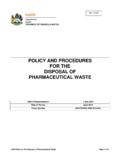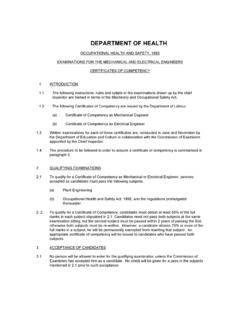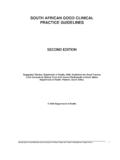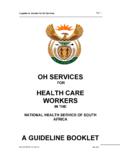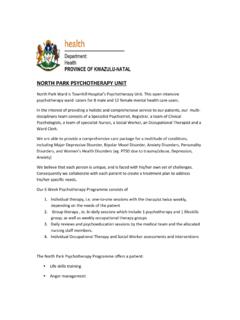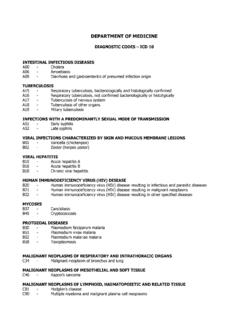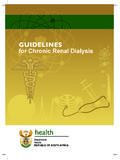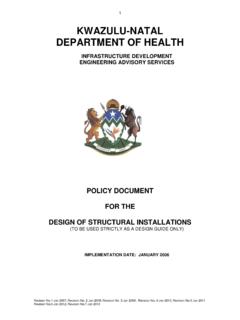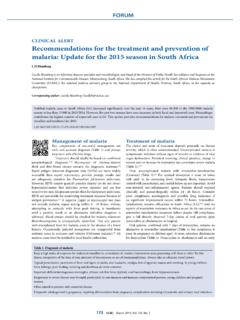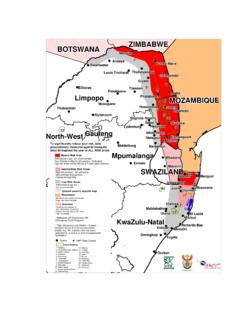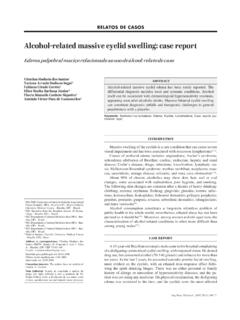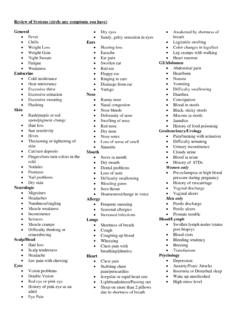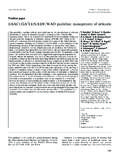Transcription of Guidelines for the Use of Thyroid Function Tests Grey’s ...
1 Guidelines for the Use of Thyroid Function Tests Grey s hospital laboratory Pietermartizburg complex compiled and adapted by Dr. R. Sirkar Chemical Pathologist UKZN August 2006 compiled and Adapted by Dr. R. Sirkar - Chemical Pathologist 1 Indications for Thyroid Function Testing Screening for Thyroid Dysfunction Which Thyroid Function Test? As a baseline screening test TSH sampling will be done on all samples received for TFTs. Free T4 and T3 will be done if requested for and if warranted by the supplied brief history and on samples with abnormal TSH results. Special situations: Goitre and Thyroid Nodules In any patient presenting with a suspected goitre, serum TSH should be measured Atrial Fibrillation, Hyperlipidaemia, Osteoporosis, Subfertility Patients with atrial fibrillation, dyslipidaemia, osteoporosis and subfertility should have an assessment of Thyroid Function by measurement of serum TSH at presentation Women with Type 1 Diabetes Women with type I diabetes should have their Thyroid Function , including serum TSH, FT4 and Thyroid peroxidase antibody status, established preconception, at booking when pregnant and at 3 months post-partum The Normal Healthy Adult Population Including the Elderly Screening for Thyroid dysfunction in a healthy adult population is not warranted.
2 Case-finding in women at the menopause or if visiting a doctor in primary care with non-specific symptoms may be justified in view of the high prevalence of mild Thyroid failure If screening is performed, and a high serum TSH concentration is found, and the FT4 is normal, the measurement should be repeated 3-6 months later, along with measurement of serum FT4, after excluding non-thyroidal illness and drug interference If the serum TSH is greater than 10mU/L and the serum FT4 concentration is low, then the subject has overt hypothyroidism and should be treated with thyroxine If the serum FT4 concentration is normal, but the serum TSH concentration is greater than10mU/L, then treatment with thyroxine is recommended If the serum TSH concentration is above the reference range but <10mU/L,then serum Thyroid peroxidase antibodies should be measured.
3 If the serum antibody concentration is high, then serum TSH should be measured annually or earlier if symptoms develop; thyroxine therapy should be started if the serum TSH concentration rises above 10mU/L. If the serum antibody concentration is not raised, then repeat measurement of serum TSH approximately every three years is all that is required compiled and Adapted by Dr. R. Sirkar - Chemical Pathologist 2 There is no evidence to support the benefit of routine early treatment with thyroxine in non-pregnant patients with a serum TSH above the reference range but <10mU/L Physicians may wish to consider the suitability of a therapeutic trial of thyroxine on an individual patient basis. If a serum TSH concentration below the reference range but > is found, then the measurement should be repeated one or two months later together with serum FT4 and FT3, after excluding non-thyroidal illness and drug interferences If the serum TSH is less than then the serum FT4 and FT3 must be measured to exclude overt hyperthyroidism If treatment is not undertaken, serum TSH should be measured every 6-12 months, with follow-up measurements of serum FT4 and FT3 if the serum TSH result is low.
4 hospital In-Patients Routine testing of Thyroid Function in patients admitted acutely to hospital is not warranted unless specific clinical indications exist compiled and Adapted by Dr. R. Sirkar - Chemical Pathologist 3 Surveillance of Thyroid Function Past History of Post-Partum Thyroiditis All women with a past history of postpartum thyroiditis should be offered an annual check of Thyroid Function and should also be screened prior to and at 6 to 8 weeks after future pregnancies Patients with Diabetes Patients with type-1 diabetes should have a check of Thyroid Function included in their annual review. Patients with type-2 diabetes should have their Thyroid Function checked at diagnosis but routine annual Thyroid Function testing is not recommended Down Syndrome and Turner's Syndrome All patients with Down Syndrome and Turner s Syndrome should have an annual check of Thyroid Function Patients receiving Amiodarone and Lithium All patients on amiodarone therapy should have Thyroid Function tested before commencing treatment and then should be routinely monitored every 6 months thereafter whilst on treatment and up to 12 months after cessation of therapy All patients on lithium therapy should have Thyroid Function tested before commencing treatment and then should be routinely monitored every 6-12 months whilst on treatment Post Neck Irradiation Thyroid
5 Function should be tested every 12 months in patients treated byexternal irradiation to the neck in view of the risk of hypothyroidism Following Destructive Treatment for Thyrotoxicosis by either Radioiodine or Surgery Indefinite surveillance is required following radioiodine or thyroidectomy for the development of hypothyroidism or the recurrence of hyperthyroidism. Thyroid Function should be assessed around four to eight weeks posttreatment,then three monthly up to one year and annually thereafter compiled and Adapted by Dr. R. Sirkar - Chemical Pathologist 4 Monitoring of Thyroid Function Treatment of Thyrotoxicosis with Anti- Thyroid Drugs It is recommended that Thyroid Function is tested every 1-3 months when initiating antithyroid drug therapy until stable and annually if used as a long term treatment option Patients on Thyroxine Therapy Once thyroxine replacement is initiated, for whatever indication, then long-term follow-up with at least an annual measurement of serum TSH is required to check compliance and dosage and take account of variations in dosage requirement caused by concomitant drug treatment In pregnancy there may be a need to increase the dose by at least 50 g daily to maintain a normal serum TSH.
6 Which should be measured in each trimester compiled and Adapted by Dr. R. Sirkar - Chemical Pathologist 5 Hypothyroidism Primary Hypothyroidism The diagnosis of primary hypothyroidism requires the measurement of both TSH and FT4 . Subjects with a TSH of >10mU/L and FT4 below the reference range have overt primary hypothyroidism and should be treated with Thyroid hormone replacement. Subjects with subclinical hypothyroidism should have the pattern confirmed within 3-6 months to exclude transient causes of elevated TSH. The measurement of Thyroid antibodies in subjects with subclinical hypothyroidism helps to define the risk of developing overt hypothyroidism. Guiding treatment with thyroxine replacement therapy . The primary target of thyroxine replacement therapy is to make the patient feel well and to achieve a serum TSH that is within the reference range The corresponding FT4 will be within or slightly above its reference range.
7 The minimum period to achieve stable concentrations after a change in dose of thyroxine is two months and Thyroid Function Tests should not normally be requested before this period has elapsed Guiding treatment with tri-iodothyronine The measurement of FT4 is of no value in patients on tri-iodothyronine replacement and the measurement of FT3 is of limited value because of the variability after taking the replacement dose. The measurement of TSH is required to optimise tri-iodothyronine replacement therapy . There is no consistent evidence to recommend the use of combined therapy with thyroxine and tri-iodothyronine in comparison to thyroxine alone Assessing response to thyroxine therapy The optimal dose of thyroxine for long-term therapy is assessed from the results of Thyroid Function Tests together with clinical finding.
8 In determining the optimal dose of thyroxine the biochemical target is a TSH result that is detectable, not elevated, and preferably within the reference range . Long-term follow-up of patients on thyroxine Patients stabilised on long-term thyroxine therapy should have serum TSH checked annually compiled and Adapted by Dr. R. Sirkar - Chemical Pathologist 6 Subclinical (Mild) Hypothyroidism Diagnosis TSH above the reference range with a FT4 measurement within the reference range. Subclinical hypothyroidism should be confirmed by repeat Thyroid Function testing 3-6 months after the original result. Guiding treatment If the serum FT4 concentration is normal but the serum TSH is >10mU/L, then treatment with thyroxine is recommended. If the serum FT4 concentration is normal and the TSH is elevated but <10mU/L then thyroxine therapy is not recommended as a routine therapy.
9 However, thyroxine may be indicated in non-pregnant patients with goitre; also in patients who are seeking pregnancy Assessing response to therapy aim of treatment should be to restore and maintain TSH within the reference range TSH should be measured 2-3 months following a change in thyroxine dose Long-term follow-up Subjects with subclinical hypothyroidism who are Thyroid peroxidase antibody positive should have an annual Thyroid Function test. Subjects with subclinical hypothyroidism who are Thyroid peroxidase antibody negative should have repeat Thyroid Function testing approximately every 3 years. Secondary Hypothyroidism Diagnosis necessitates the use of a combination of TSH with FT4. Plasma TSH can be low, within or mildly above the reference range in these patients but combined with a low Thyroid hormone measurement is suggestive of secondary hypothyroidism Secondary hypothyroidism can be distinguished from non-thyroidal illness on the basis of clinical history, measurement of FT3 and Tests of other anterior pituitary hormones Guiding Treatment The extent of hypopituitarism should be established in all patients with secondary hypothyroidism before commencing thyroxine therapy.
10 Some experts suggest that an appropriate target for adequate thyroxine replacement in patients with secondary hypothyroidism may be a FT4concentration in the upper third of the reference range. Assessing Response to Therapy FT4 measurements should be used to help define the adequacy of thyroxine replacement in patients with secondary hypothyroidism. compiled and Adapted by Dr. R. Sirkar - Chemical Pathologist 7 Long-term Follow-Up An annual check of Thyroid hormone concentration should be performed in all patients with secondary hypothyroidism who are stabilised on thyroxine replacement therapy. Congenital Hypothyroidism Congenital hypothyroidism (cretinism) is a common preventable cause of mental retardation. Diagnosis Confirmation of the diagnosis of congenital hypothyroidism involves measurement of serum TSH and FT4 in both mother and neonate and TSH receptor antibody in the mother.
